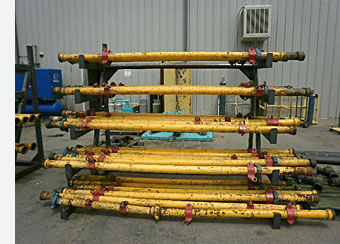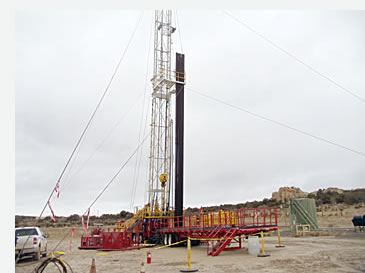|
A spike in drilling activity is also a boom for the inspection trades. Any time you have a monstrous piece of equipment such as a drilling rig – even the small ones sport booms approaching 100 feet – straining under the load of maybe a hundred thousand pounds of drill stem or casing, suffering the effects of shock loads and unavoidable physical damage you have a recipe for failures requiring inspection prior to a return to service.
Add to that horror scenario the fact that about once a week the entire shooting match is disassembled, loaded on a string of oilfield flatbeds in order to be bounced down roads showing the signs of being freshly cut by a dozer, en route to the rig’s next date with a crew of oilfield roughnecks and fifty or sixty tons of gear waiting to be augured toward oil-bearing formations. It’s a miracle they last a year but we regularly perform API Inspections on rigs which have been in service for decades.
 During the entire drilling process the wellhead is connected to a series of flow-back lines (heavy-walled threaded steel piping) which lead to a battery of flow-back tanks, each typically 300 barrel capacity (42 gallons per barrel). Any time the drill bit enters a zone which holds pressurized gas, that gas makes a run toward the line of least resistance – in this case straight for the surface. In days past drilling liquids, drilling mud and gas were simply blown out into a surface pit. Today’s environmental awareness rules that out. Everything is routed through flow-back lines to be captured in the flow back tanks for proper recycling or disposal. Obviously, the flow of gas borne high pressure/high velocity sand and drilling mud can work to erode the heavy-walled flow back pipe at an alarming rate. During the entire drilling process the wellhead is connected to a series of flow-back lines (heavy-walled threaded steel piping) which lead to a battery of flow-back tanks, each typically 300 barrel capacity (42 gallons per barrel). Any time the drill bit enters a zone which holds pressurized gas, that gas makes a run toward the line of least resistance – in this case straight for the surface. In days past drilling liquids, drilling mud and gas were simply blown out into a surface pit. Today’s environmental awareness rules that out. Everything is routed through flow-back lines to be captured in the flow back tanks for proper recycling or disposal. Obviously, the flow of gas borne high pressure/high velocity sand and drilling mud can work to erode the heavy-walled flow back pipe at an alarming rate.
Once the wells are drilled, they are then cased – threaded pipe forms a lining inside the drill hole from top-to-bottom, sometimes miles in depth. Next comes the cementing step, whereby all aquifer levels are sealed off in concrete, precluding any possibility that the precious trinity sands could be contaminated by liquids used in the production process. In the next step Wireline Trucks may come in to do well logging which identifies the exact depth zone which should produce the most oil or gas. Once that zone is identified the well casing is perforated at that depth to allow access to that formation.
In many cases the next step calls for a high-horsepower procedure called a Frac Job. Depending on the depth and strata characteristics of each well a battery of 300-barrel frac tanks are hauled to the well site and filled with water. Next to arrive will be a small fleet of very large trucks, each pulling a trailer bearing a monster diesel engine coupled to a huge pump and a series of valves and piping. The trucks connect, one to the next in turn, and finally to the wellhead.
Using the water stored in the frac tanks the frac trucks fire up those huge engines and then working in concert they build up incredible hydraulic pressure which is directed down the well, through the perforated well casing and into the heart of the oil-bearing formation. That incredible pressure  opens or fractures the formation, allowing the oil or natural gas and gas-borne liquids to flow. Of course, pressure like that also takes a toll on tanks and pressure lines as well. opens or fractures the formation, allowing the oil or natural gas and gas-borne liquids to flow. Of course, pressure like that also takes a toll on tanks and pressure lines as well.
This highly simplistic description of all the operations necessary to get one oil/gas well to flow productively barely scratches the surface of the full story of drilling. But note that each of the operations, from drilling to frac, contained elements of stress, pressure and erosive elements that eat cold steel like snack food. Every component in this journey to completion, and every part in those components must be inspected and re-inspected, year after year. Tanks, trucks, frac and flow-back pressure lines, drilling rigs, lifting gear, workover rigs and wireline rigs must all be inspected, weld by weld – thank goodness.
 Top Top
|















